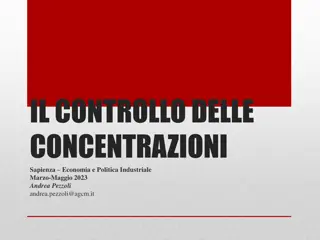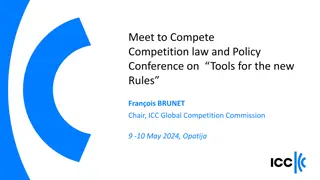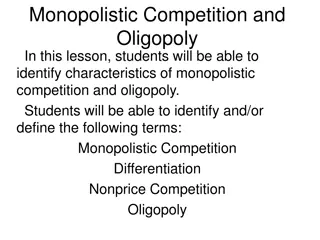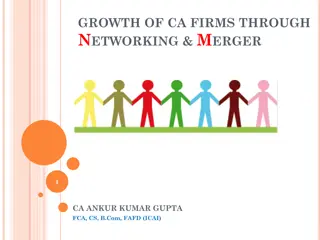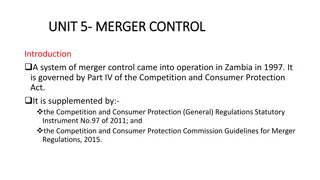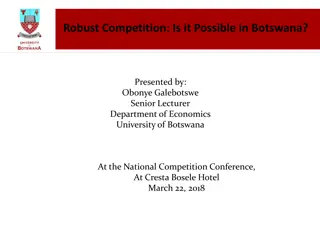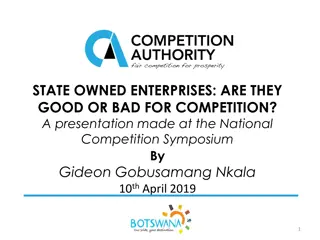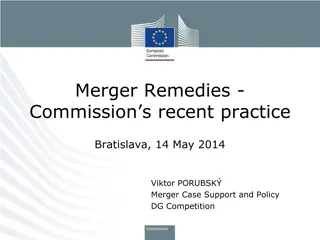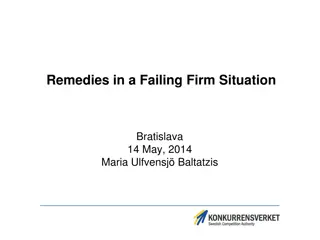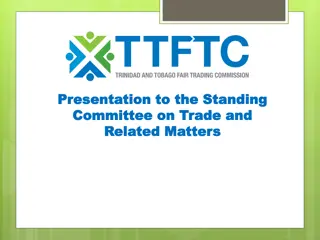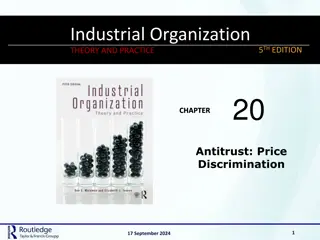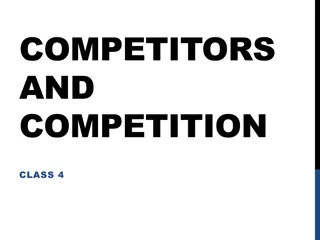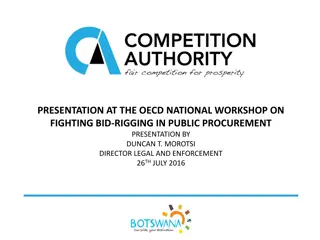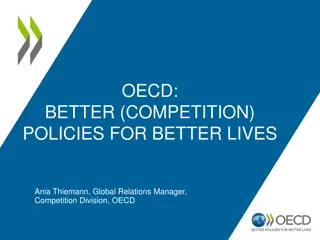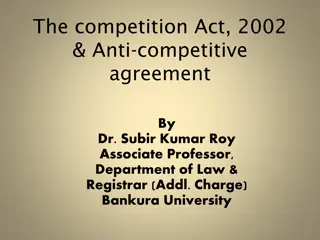Understanding Competition Laws and Merger Analysis
Explore the nuances of competition laws, merger analysis, and investigation planning at the African Consumer Protection Dialogue Conference. Learn about types of anticompetitive conduct, horizontal and vertical mergers, and effects of mergers on competition. Gain insights into theories of harm, sources of information, investigative tips, and a case study exercise to enhance your understanding.
- Competition Laws
- Merger Analysis
- Investigation Planning
- African Consumer Protection
- Anticompetitive Conduct
Download Presentation

Please find below an Image/Link to download the presentation.
The content on the website is provided AS IS for your information and personal use only. It may not be sold, licensed, or shared on other websites without obtaining consent from the author. Download presentation by click this link. If you encounter any issues during the download, it is possible that the publisher has removed the file from their server.
E N D
Presentation Transcript
Breakout Session 4: Developing an Investigation Plan Fifth Annual African Consumer Protection Dialogue Conference Livingstone, Zambia
Overview Competition laws Merger analysis: a very brief review A taxonomy of transactions Unilateral effects of horizontal mergers Planning the Investigation Theories of harm Sources of information Timing and tasks Investigative tips Case Study Exercise Focusing and Managing the Investigation
Competition Laws Most competition laws address three generally recognized types of private anticompetitive conduct that hurt competition Anticompetitive mergers Collusion between competitors Exclusionary conduct by dominant firms Called monopolization in the United States Called abuse of dominance in most other places
Merger Analysis (I): A Taxonomy Horizontal mergers Mergers between producers of substitutes, i.e. products / services within the same relevant market Examples: two brands of toothpaste, two mobile network operators, two grocery stores or clinics (in the same geographic market) Vertical mergers Mergers between producers of complements, i.e. products / services are inputs to one another Examples: manufacturer and distributor, petrol producer and fuel retailer, gin and tonic producers Conglomerate mergers Mergers between producers of competitively unrelated products? Example: cars and washing machines? Beware presumptions based on characteristics !
Merger Analysis (II): Horizontal Mergers Pro-competitive effects of horizontal mergers displacement of ineffective management realisation of savings through the elimination of fixed costs realisation of savings through the reduction of variable costs Anti-competitive effects of horizontal mergers Unilateral effects (non-coordinated effects): the creation of market circumstances that permit the merged firm to raise the price of some or all of its products / services (or otherwise compete less effectively, e.g. in terms of range, quality or service), without any change in the nature of competition Coordinated effects: the creation of market circumstances that change the nature of competition such that the merged firm and its rivals are able to tacitly coordinate their actions in order to compete less intensively
Merger Analysis (III): The Basics If a merger does not create, protect, or enhance market power, it should be cleared Market power: the ability profitably to sustain prices above competitive levels where competitive constraints are not effective Competitive constraints Existing competition: firms already in the market (effectiveness gauged by, among other things, market shares, barriers to expansion) Potential competition: firms that may enter the market and prevent exercse of market power (effectiveness gauged by entry barriers) Buyer power: credible threats to switch to new suppliers or sponsor entry and growth (but do all customers have this threat?) With mergers, the issue is whether prices (or, quality adjusted prices) would rise relative to the counterfactual , i.e. the level that would otherwise have occurred absent the merger
Merger Analysis (IV): Unilateral Effects Unilateral effects arise when two closely competing products are brought under common ownership The price of the two parties products is likely to rise because sales which would have previously been lost to the acquiring firm are partially recaptured in higher sales of the acquired firm (and vice versa) The higher the share of lost sales diverted from one merging party to the other the higher will be the unilateral incentive to raise price These effects do not rely on any accommodating response by the firm s remaining competitors (unlike coordinated effects)
Merger Analysis (V): Unilateral Effects Homogeneous products Mergers where products are (almost) identical from the point of view of consumers If products are (more or less) commodities, the main issue is the extent to which non merging parties face barriers to growth capacity constraints switching costs awareness of rival offers Mergers of firms with relatively large market shares may not give rise to a significant lessening of competition (SLC) where products are commodities and non merging parties face no barriers to growth
Merger Analysis (VI): Unilateral Effects Differentiated products Differentiation may be by: geography, product characteristics, time, switching costs, marketing, consumer information Most products differentiated to some degree question is whether so differentiated that market shares not meaningful Mergers of closer competitors more likely to lead to higher prices than mergers of distant competitors but, even mergers between close competitors unlikely to be problematic if sufficient competitive constraints remain: Other close competitors exist and do not face barriers to growth Supply side responses new entry, product repositioning into the product or geographic space of concern Demand side responses, e.g. buyer power
Planning: Initial Phases Main goal in initial phase is to determine quickly whether to conduct an in-depth review If no obvious competitive concerns, no formal plan required Quick review of notification filing or public data may suffice Goal is to clear transaction quickly If concerns raised by preliminary review, develop initial plan Initial phase should focus on extent to which further investigation is required Can often be focussed to a single threshold issue Focus on a few discrete tasks and, where appropriate, limited information requests, calls and/or meetings Timing critical; as are other constraints and priorities: both internal and external See ICN Investigative Techniques Handbook for Merger Review
Planning: In-Depth Investigations Investigation plan should address three key issues: Theories What are the primary areas of concern / candidate theories of harm? Evidence What factual evidence is needed to address critical issues? What are the best sources of the required information? Tasks and constraints Who does what, when? What are the timing and resource constraints? Commit to initial deadlines and responsibilities, revisit and revise plan as investigation develops if necessary
Investigative Tip 1: Prioritize and Focus Identify issues based on authority Does the available information suggest any compelling way the issues pose a potential competitive problem? Is there any information that rules out a potential for a competitive problem, such as a large number of significant competitors or low barriers to entry? Before concluding ask what further investigation would be helpful
Investigative Tip 2: Get the Targets Help Learn target s view on antitrust issues What is the rationale for the conduct Have the parties business people educate you Talk to the marketing people or the person that can tell you how prices are set or negotiated Ask the target to back it up. Obtain key ordinary course of business document such as Strategic and business plans Studies Board presentations on conduct, particularly those describing any synergies Pricing plans Test competitive concerns by disclosing them to the target The disclosure will help you to learn the evidence and arguments that you will need to overcome in any challenge
Investigative Tip 3: Interviews Learn from competitors Product overlaps how firms compete on price, service or innovation. Entry conditions market shares, market structure, and history Learn from customers The number and strength of competitors? What substitutes are available? Do they have any concerns? Are there anecdotes of past competition issues
Planning: Case Exercise - Background The acquiring firm is BigBox Wholesalers (Pty) Ltd. BigBox owns and operates a national chain of grocery wholesale outlets throughout the fictional republic of Mzansi. Two of its outlets are located in East Port, a coastal city one in the city centre and one on the outskirts of the city. The target firm is Eagle Cash & Carry (Pty) Ltd, an independent wholesaler of grocery products in East Port. Eagle has a single outlet in the centre of East Port. BigBox and Eagle supply groceries, liquor and general merchandise primarily to independent retail outlets and convenience stores. The parties product offerings cover a full range of edible and non-edible grocery products, including perishable (frozen and refrigerated) and non- perishable food, household cleaning products, toiletries, catering supplies, tobacco products, over the counter patent medicines, as well as a range of general merchandise such as toys, electrical goods, crockery, paint, stationery, ornaments, and household utensils Eagle has, from time to time, procured stock from BigBox
Planning: Case Exercise Value Chain Manufacturers / Suppliers (e.g. Coca-Cola, Procter & Gamble, Cadbury, Unilever, Nestle) Buying Groups Distribution Centres Wholesalers (e.g. BigBox and Eagle) Independent Retail (e.g. superettes, garage forecourts) Corporate Retail Consumers
Case Exercise Filing Information (I) In their merger filing notification, the parties provide the following rationale for the transaction: BigBox is focussed on constructing and maintaining a supply chain to independent low-end retailers that is as competitive as the distribution centre models of the large retailers, while maintaining better service levels than the national retailers The proposed transaction will facilitate the negotiation of better prices from manufacturers at a regional level based on higher purchase volumes, and greater economies of scale will lower distribution costs The Eagle business will complement the BigBox grocery offering as BigBox has a significantly stronger presence in toiletries and general merchandise than Eagle The current owners of Eagle wish to retire
Case Exercise Filing Information (II) In support of their case for approval, the merging parties submit that: The relevant product market is broad and includes both wholesalers and large integrated retail chains The relevant geographic market is no narrower than East Port and its surrounding areas Even if the relevant product market is restricted to wholesalers, the merged entity will have a post-merger share of less than 40%, and will continue to be constrained by at least 7 other wholesalers and post-merger, 3 with shares greater than 10% The merged entity s combined share in any event overstates the extent to which they competitively constrain each other given their differentiated offerings, in terms of product range and mix (Eagle is strong in confectionary, while BigBox is prominent in general merchandise and toiletries), location, credit and delivery terms (Eagle does not offer these services), i.e. the merging parties are not close competitors Barriers to entry in wholesaling are low, and upstream suppliers possess countervailing power.
Case Exercise Initial Information (I) The competition authority has compiled the following information from the responses to initial information requests Wholesale Market Shares (2012 Revenues) Greater East Port Market Shares (2012 Revenues) Central East Port BigBox 25% BigBox 35% TradeValue 19% TradeValue 26% United Cash & Carry 16% Eagle 18% Afri-Save 15% Eagle 13% Afri-Save 11% Jumbo Stores 6% Orient Wholesaler 6% Total 100% Usave C&C 6% Jumbo Stores 4% Total 100% - - - United Cash & Carry entered only 2 years ago Last year, Afri-Save had a market share of less than 5% In the last 6 months, USave C&C moved away from Central East Port to the outlying suburbs its market share last year was 7%
Planning: Candidate Theories of Harm Set out a summary description of the transaction BigBox, a large national wholesale chain, and the largest wholesaler in East Port, proposes to acquire Eagle Cash & Carry, an independent wholesaler in East Port Distil the reason(s) to investigate further Merger would combine the #1 and #4 wholesalers in greater East Port, and the #1 and #3 wholesalers in central East Port Develop a working theory of harm (and, if appropriate, remedies to be sought) Merged firm could charge higher prices to independent retailers in East Port (and/or otherwise degrade their service) if the parties are particularly close competitors and control a substantial share of sales in a well-defined narrow market for wholesale in central East Port and if price increases would not be defeated by entry and/or expansion into that market. Identify the key factual issues to be resolved Geographic market Closeness of competition Entry / Expansion
Planning: Evidence Goal: Gather sufficient information through the pre-notification stage, merger notification stage and Phase I review to determine whether the transaction should be cleared or if a Phase II review is warranted Types of information needed to resolve key questions Price and quantity data Customer churn / switching data Sources of information Merging parties Competitors Customers Methods to gather information Interviews Written requests for information or document production (voluntary or compulsory) Surveys
Planning: Administrative Tasks & Timing Overall timing plan Key deadlines for the investigation Agenda / schedule Specific task schedule that prioritizes and assigns tasks Identify tasks, specific actions, responsibilities and target dates Track and monitor progress Administrative items Analytical economic projects Coordination with other agencies and/or jurisdictions Expert projects Staffing needs
Planning: Keeping Assessment Focussed Planning is continuous Develop and prioritize candidate theories Identify potential issues, pursue those most likely to reveal effects Discuss theories of competitive harm Expose arguments to critical analysis from merging parties and third parties Test with evidence, reevaluate and revise Test theories with facts, revise theories according to facts Focus the Facts Prioritize and narrow the search for relevant information The critical and possibly disputed facts become narrower as the matter progresses
Planning: Managing Investigation and Evidence Organize the Information Develop a document that organizes case information (by product or by issue) Consider how technology may help you be more efficient Maintain Communications Dialogue with Merging Parties regular opportunity to discuss progress Dialogue with Third Parties can provide crucial fact information and perspectives on merger Keep decision makers informed Keep an eye on the clock Investigation team should use the initial phase to frame issues for inquiry and quickly identify issues that are not of concern In an in-depth review, the investigation team may confront timing issues in three contexts: Statutory Periods Internal Timetables Timing Agreements Managing an investigation within time limits is a challenge


